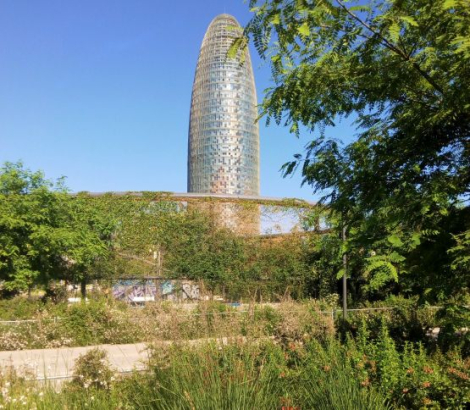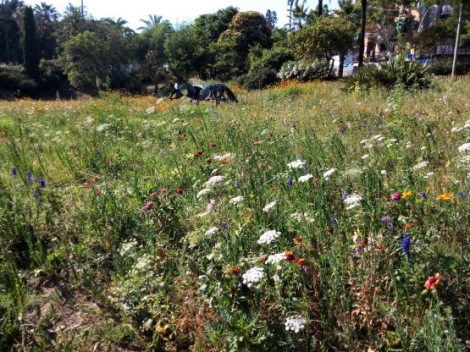Urban greenery is not quite what it seems!
- Urban visions
- Oct 23
- 11 mins
Urban spaces are ecosystems inhabited by humans and, as such, need to be managed in a manner that recognises that resources are finite and that sustainability and the protection of biodiversity must be ensured. Applied ecology, as opposed to functional gardening —which is now inadequate and obsolete—, provides cities with greater CO2 absorption, savings in the natural water cycle, less costly maintenance, more ecological connectivity, greater soil permeability… In short, the aim is to apply the green infrastructure model, which emerged from the conclusions of the 1992 Earth Summit.
Lately, we have been hearing highly critical opinions about the definition of public space and urban greenery in Barcelona. The actions rolled out are apparently the product of huge political propaganda based on the ideas of a few enlightened individuals who are not very sensible, or even rational. However, changes of model do happen for other reasons. Even more so if they come at the same point in time and in different places far apart such as Barcelona, Moscow, Tirana and cities in Canada and the Netherlands, and involve the United Nations, the European Union and the International Union for Conservation of Nature (IUCN). Evidently, having an opinion does not require much judgement or sound advice; all you need to have is an ideology, a phobia, a fixation or be opposed to everything. But that’s not exactly how things work out, at least in this case.
Insights
The 1992 Earth Summit has seen a before and an after in the way we understand the role of humans on the planet. That year, the paradigm underwent a radical shift, based on an almost indisputable conceptual and scientific soundness.
Prior to the summit, human activity was based on the use of resources as if they were unlimited, as if the planet were infinite. No sensible businessperson would ever think of running a company according to such criteria. For the first time, the planet was becoming increasingly smaller to us.
In terms of protecting endangered species, the focus was on species with some sort of appeal in the eyes of humans: aesthetically fortunate, popularly or culturally appealing, or iconic. This resulted in the biased protection of a few hundred species and neglected many other vulnerable ones.
Lastly, as regards the protection of natural areas, areas were chosen mainly for their monumental nature or aesthetic interest. As these sites did not accurately represent the full gamut of ecological scenarios, the result was an incomplete preservation of a few sites in each country.
This overview stands in stark contrast to developments since the 1992 Earth Summit. Environmental issues had gone from being occasional and local to global and territorial, which is a major and unexpected challenge. Moreover, a relevant factor is that these changes were happening very rapidly, over just a few decades. Changing the way humans understood and interacted with the biosphere was imperative. Thus, the definition of sustainability emerged. Change is gradually taking place, but there are still some humans who have not understood it and maintain a denialist mindset.
In terms of species protection, the summit called for the preservation of “all” species (biodiversity), i.e. the several million species on the planet and not just a few hundred. These species constitute a heritage asset created in the course of the evolutionary process of life and are a set of successful biological programmes replete with survival properties.
 Outdoor view of a hub of activity in Plaça de les Glòries Catalanes. © Clara Montaner Augé
Outdoor view of a hub of activity in Plaça de les Glòries Catalanes. © Clara Montaner AugéIn terms of protected areas, a major evolution has also taken place: they have become a more complete and meaningful representation of the ecosystems inhabited by well-connected biodiversity, rather than a series of isolated singularities. They are spaces that contain the habitats that supply the conditions and resources that biodiversity needs to live and thrive.
We have long been aware that urban spaces are ecosystems: human habitats. They are essential to us, but so are non-urban ones. We depend on agricultural and livestock production, but we also suffer from the waste problems they generate. We are aware of the benefits of tourism, but also of the imbalances it creates. We are cognisant of the importance of industrial development, but also the pollution that it can produce. We are aware of the importance of water, but also of the need to save, store and use this resource. Today we are in a position to understand and design urban spaces in a manner that is integrated with land use, urban, ecological, social, health, economic, mobility, communication, services, recreation and landscape factors... Our awareness of all these matters means that we have a responsibility to design and build urban spaces based on these parameters in the future.
A smart solution for urban space design
The task at hand was how to bring about this change. It was a major challenge, the outcome of an inevitable development process. Indeed, the understanding of land use and urban spaces hastened the concept of green infrastructure. The European Union, in 2013, defined it as “a strategically planned network of natural and semi-natural areas and other environmental features, designed and managed to provide a wide range of ecosystem services, while also enhancing biodiversity in both rural and urban settings”. Consequently, human habitats (cities and towns) designed and built according to an old concept are now confronted with an overhaul of the model, to overcome the major shortcomings they have and that we find so hard to acknowledge.
Human habitats are now confronted with an overhaul of the model, to overcome the major shortcomings they have and that we find so hard to acknowledge.
Using the land as the main infrastructure available to us, however, reveals a new dimension of our responsibility to us. Indeed, all the resources we need come from the land and therefore from nature. Any shortages are met by using available but finite resources, which give us security, stability and comfort. However, nature is not an endless larder, but comprises a certain number of elements: some are plentiful and others are scarce; some are very rare and others are very common; some regenerate over time, and some cannot regenerate beyond their lifetime, as if they were savings; some have passed the tests of survival (at least for the time being), and are alive as a result of many trials and errors.
To achieve the implementation of green infrastructure, a new instrument called nature-based solutions (NBS) needs to be applied. The European Commission, in 2020, defined nature-based solutions for climate change adaptation and disaster risk reduction as “actions that work with and enhance nature to restore and protect ecosystems and to help society adapt to the impacts of climate change and slow further warming”. A new approach stemming from the NBS is to shape urban green spaces by comparing them with local habitats (habitat template). The motivation is clear: native habitats are well adapted and appropriate to local environmental, soil substrate and climate conditions. They are equipped with the necessary resources for the biodiversity concerned to successfully complete their biological cycle. They also have the capacity to establish, among interacting species in a given location, the emerging properties that define ecosystems.
All these aspects strengthen the habitat’s dynamic stability over time and ensure a good level of ecological complexity. The fundamental idea is to ensure the ecosystem’s gradual maturation, which will be strengthened over time by the ecological interactions that become intertwined: competition for space and nutrients, population dynamics of the species concerned, colonisation and loss, etc.
 Detail of the biodiverse grassland strip in Guineueta Park, in the Nou Barris district. © Clara Montaner Augé
Detail of the biodiverse grassland strip in Guineueta Park, in the Nou Barris district. © Clara Montaner AugéOn this basis, we now have a set of proven NBS to develop green infrastructure. Firstly, through the restoration, recovery and ecological rehabilitation of areas, using existing but now modified techniques. The new approach lies in the fresh vision of the goals and the technical solutions applied. Examples include the recovery of river, coastal and forest ecosystems, soil decontamination and the stabilisation of banks and slopes.
Secondly, the implementation of actions for the creation of urban greenery (parks and gardens), addressing them from the perspective of applied ecology; that is, from the perspective of functional gardening and not classic gardening, which is now inadequate and obsolete. This results in more continuous cover, with greater CO2 absorption, more species, more ecological connectivity; a natural water cycle with greater savings, greater soil permeability, lower maintenance costs… Actions of this type include, for example, the creation of continuous tree canopies; hubs of biodiversity and activity, surrounded by a green enclosure; multi-species areas of shrubs and herbaceous plants, with or without scattered trees; vegetated areas on slopes; wide rows of trees or multi-species shrubs; areas with vegetation; climate shelters…
Finally, the creation of micro-habitats for certain key species or biological groups to enhance biodiversity either in synergy with or complementary to the overall action envisaged. Examples include temporary, seasonal or permanent ponds and reservoirs; green facades, walls and canopies; insect hotels; bio-trunks; rock features; nest boxes (for birds, bats, etc.); burrows and dens; and micro-reserves for butterflies, among others.
Fostering the presence of biodiversity improves the greenery’s resilience to disturbances.
These elements foster the presence of biodiversity, not for collection purposes, but in pursuit of ecological quality. This translates into greenery that is more capable of accommodating more species and of being resilient to potential disturbances. Introducing these ecosystems enhances the stability (resistance and resilience) of urban greenery, improves ecological functionality and increases ecosystem services for the population (soil conservation and soil quality, increased CO₂ fixation, improvement of air quality and water cycle, psychological well-being, environmental comfort, etc.). There is one more practical aspect to be taken into account when creating these habitats: we must not succumb to demands or inflexibility that are not at all advisable because we wish to replicate the benchmark habitat precisely.
Land-use planning not only from an urban planning perspective
We are aware that human activity is increasingly exerting a significant impact on the world’s ecosystems. The changes that have taken place have contributed to substantial net benefits in the development of human and economic well-being. Nevertheless, these benefits have come at ever greater costs in the form of the degradation of many ecosystems, a non-linear increase in risks and the exacerbation of poverty for some population groups. The green infrastructure model proposes a less detrimental approach, a new model based on nature where the goods and services (ecosystem services) we obtain provide us with the resources and activities we humans need, while ensuring our present and, above all, future well-being, as well as health and economic and social development.
Until a few years ago, land-use planning had been a matter addressed from an urban planning and therefore anthropocentric point of view, and the focus was primarily on urban spaces. An urban vision is of the utmost importance, but it has been biased. And, as a result of this bias sustained over time, urban spaces have been designed in a biased manner, with an ecological vision that is either non-existent or clearly secondary. From today’s perspective, this approach is obsolete. Therefore, to claim that cities have always worked in this way and that there is no need to design them differently is a matter of ignorance and closed-mindedness, especially considering today’s evidence and proof of the adverse consequences on the quality of life of people and the planet. This is essentially why all these changes are being brought about.
The newsletter
Subscribe to our newsletter to keep up to date with Barcelona Metròpolis' new developments




